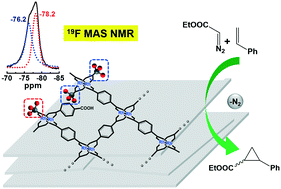Heterogeneous self-supported dirhodium(ii) catalysts with high catalytic efficiency in cyclopropanation – a structural study†
Abstract
Catalytically active dirhodium sheet-like coordination polymers are synthesized from their precursors via ligand exchange. The individual lamellae of the dirhodium-bdc frameworks are stacked as parallel sheets, which are randomly oriented or slightly ordered. As inorganic building blocks Rh2(TFA)4 and Rh2(OAc)4, and as organic linker benzene 1,4-dicarboxylate (bdc) are employed. The successful synthesis of the Rh2-bdc(Tf) and Rh2-bdc(Ac) catalysts is proven by ATR-IR, XPS and 13C CP MAS NMR. Residual trifluoroacetate species are investigated by quantitative 19F MAS NMR which further reflects the configuration of trifluoroacetate in the obtained Rh2-bdc(Tf), and defects in the structure. DR-UV-vis and XPS demonstrate that the oxidation state and the Rh–Rh single bond in the dirhodium node are maintained during the ligand substitution process. The stability and reusability of the catalysts are verified by TG-DTA measurements and leaching tests. The catalysts show similar catalytic efficiency as the homogeneous catalyst in the model cyclopropanation between ethyl diazoacetate (EDA) and styrene.



 Please wait while we load your content...
Please wait while we load your content...